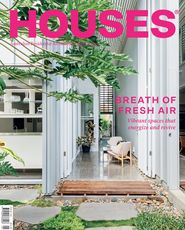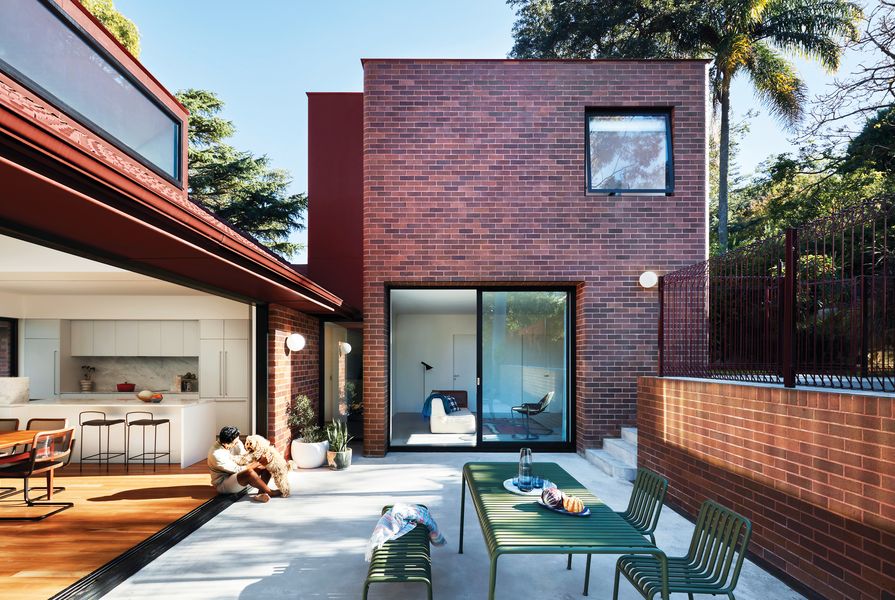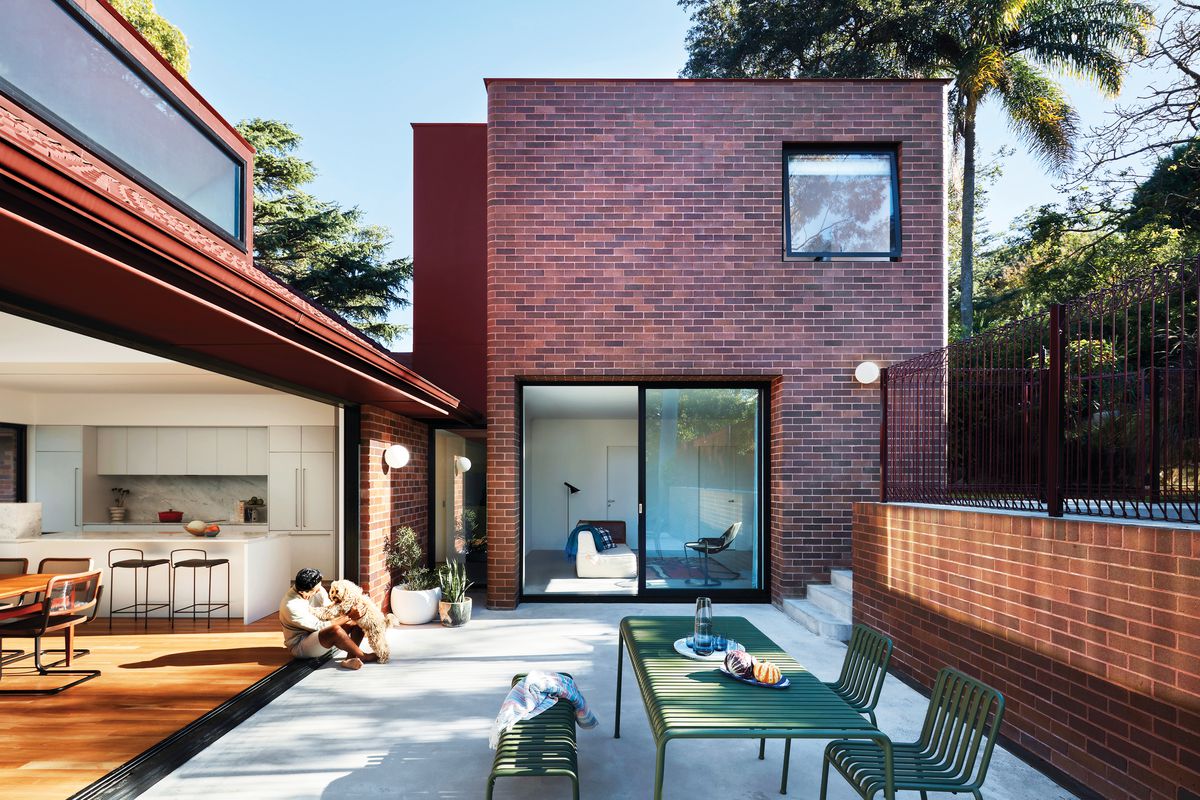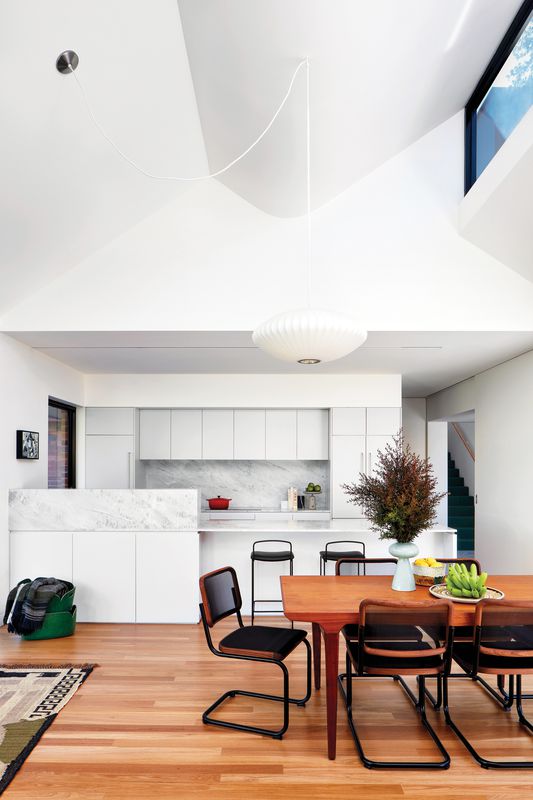There are many factors that make a home special. Sometimes it’s the memories, or the neighbourhood, or perhaps a view. However, as much as you might like your home, if it’s not working for you at a particular stage in life it raises the question: what to do? Move to a more suitable house? Or make the place you love work? Those Architects addressed these questions for a growing family in Sydney’s leafy North Shore with a rebuild that meant the family could stay put in the home that they knew – but now in a house that they loved.
The original house could be described as “curious.” The mid-twentieth-century red-brick house is perched high on a steep embankment that tumbles down to gum tree-filled bushland. A semi- circular prow bulges out from the facade and is capped by a hipped roof that sits flat like a lid. The house as it was had a southerly aspect that was directed towards the bush, while to the north it was blocked in by a lean-to. For a family with young children, the house just wasn’t working and didn’t take advantage of the picturesque setting.
The living space is crowned by a north-facing lantern that scoops toward the sky, bouncing light off curves in the ceiling. Artwork: Kirsty Budge.
Image: Luc Remond
The clients were on the hunt for an architect to help them transform their brick box into a twenty-first-century house. They had seen the work of Those Architects and were impressed by the practice’s approach. Simon Addinall, director at the practice, said the client came to them with an initial idea for reordering the house and site. After some consultation and careful analysis of the site and difficult terrain, Those Architects flipped the client’s ideas on their heads – literally. In order to fully take advantage of the existing structure of the house, as well as the northerly aspect to the rear, an L-shaped configuration was proposed. The children’s zone would be housed in a two-storey tower at the back, the semicircular prow would become the parents’ zone and the body of the house would be the central living and kitchen area.
This straightforward but effective spatial organization can be seen to embody the approach of Those Architects – maximize light and air, minimize circulation, connect all interior spaces to the exterior. Nowhere is this seen better than in the central living space. Where once there had been a few poky windows to the south, now a large section of glazing opens onto a balcony that fronts a beautiful angophora, with glimpses of the harbour in the distance. To the northern side, the lean-to has been removed and large sliding doors open the room completely to the courtyard area. The most spectacular feature in the living space is the north-facing lantern that scoops in the sky and bounces light off the series of curved elements. The double aspect of this space, plus the theatrics of the lantern, make it a wonderful place to be. One of the clients is a chef so the kitchen is an important part of the room. Elba marble and soft grey joinery complement moss-green highlights in the rest of the space. The original house is floored with blackbutt timber, and the new tower and courtyard in concrete. In the parents’ zone, at the curved front of the old house, all the original plaster cornices have been kept, as well as the steel windows that look onto the trees. Being elevated from the street means that the bedroom can fully exploit the glazing without compromising privacy.
The original home’s semicircular prow has been converted into a parents’ retreat, with views to gum tree-filled bushland below. 03
Image: Luc Remond
The children’s tower is connected physically to the courtyard and visually to the living space. If the parents want a bit of peace and quiet the tower can be closed off by sliding doors. This tactic has been used in the living space and the parents’ zone as well, allowing for different visual and spatial configurations to be implemented depending on who wants to be where at any given time. The moss green from the living space is intensified into a forest green carpet that leads to the upper bedrooms. From the exterior, the tower is beautifully detailed with bullnose-corners and brick-clad reveals. It sits well between the embankment and the existing house forming a stepped gradation of elements. The architects tried to select a brick colour as close to the original as possible, so that the new tower would read cohesively with the existing house.
Taking cues from the brick and the surrounding gum trees, the trims and gutters are painted in an ochre red. Those Architects used very familiar schoolyard-style fencing to enclose the pool. Powdercoated in red, this everyday material shows its versatility and the robust nature of the architects’ approach to materiality and detail.
The clients couldn’t be happier with their old home and new house. They still have that great view, the lovely neighbours and the smell of gum trees. Architects aim to make people’s lives better through good design – Those Architects has accomplished this.
Products and materials
- Roofing
- Lysaght Klip-lok roofing in Colorbond ‘Windspray’ and gutters and flashings in Colorbond ‘Manor Red’.
- External walls
- Bowral Bricks dry-pressed bricks in ‘Gertrudis Brown’; roughcast render; painted fibre cement in Dulux ‘Red Box’; painted render in Dulux Weathershield ‘Fair Bianca Half’.
- Internal walls and ceilings
- White set render walls, and plasterboard walls and ceilings in Dulux Wash and Wear ‘Fair Bianca White’.
- Windows
- B and W Aluminium Windows and Doors powdercoated aluminium-framed windows.
- Doors
- B and W Aluminium Windows and Doors powdercoated aluminium-framed doors; Parisi door hardware.
- Flooring
- Blackbutt floor in Bona Naturale treatment; honed concrete; Tretford goats’ wool carpet in ‘Silver Birch’, ‘Magenta’ and ‘Evergreen’; Winckelmans tiles in ‘Pistachio’ and ‘Black’ from Olde English Tiles.
- Lighting
- Artemide wall and external lights; JSB Lighting LED strip lights; Louis Poulsen AJ Floor lamp and Nemo Parliament Floor Lamp from Cult; Flos Snoopy table light from Euroluce.
- Kitchen
- Custom 2-pac joinery in Dulux ‘Paramount Design’ by Luke Geercke Cabinetmakers; Artedomus Elba Honed benchtops; Abey sink and tapware; Miele oven and cooktop; Falmec rangehood; Bosch dishwasher; Fisher and Paykel fridge/freezer.
- Bathroom
- Surface Gallery terrazzo floor tiles and ceramic wall tiles; Duravit basins; Sussex tapware and towel rails in ‘Matt Black’; Kaldewei bath; Parisi Linfa toilet.
- Heating and cooling
- Mitsubishi Electric air-conditioner.
- Other
- Hay Palissade outdoor furniture; Louis Poulsen AJ floor lamp by Arne Jacobsen from Cult; Moroso Net table from Hub.
Credits
- Project
- House Lincoln by Those Architects
- Architect
- Those Architects
Australia
- Project Team
- Simon Addinall, Ben Mitchell, Emiliano Miranda, Luke Hallaways
- Consultants
-
Builder
Harding and Lindsay Building
Engineer Harrison and Morris Consultancy
Hydraulic engineer ITM Design
Stylist Felicity Ng
- Site Details
-
Location
Sydney,
NSW,
Australia
Site type Suburban
Site area 668 m2
Building area 185 m2
- Project Details
-
Status
Built
Completion date 2019
Design, documentation 9 months
Construction 12 months
Category Residential
Type Alts and adds
Source

Project
Published online: 3 Dec 2021
Words:
Sing d'Arcy
Images:
Luc Remond,
Those Architects
Issue
Houses, February 2020
























